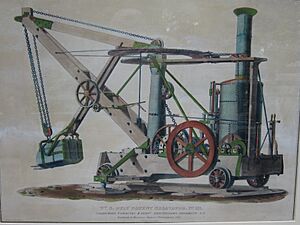William Otis facts for kids
Quick facts for kids
William Smith Otis
|
|
|---|---|

Portrait by Bass Otis, c. 1835
|
|
| Born | September 20, 1813 Pelham, Massachusetts, U.S.
|
| Died | November 13, 1839 (aged 26) |
| Nationality | American |
| Known for | Inventor of the steam shovel |
| Relatives | Elisha Otis (Cousin) |
William Smith Otis (September 20, 1813 – November 13, 1839) was a clever American inventor. He is famous for inventing the steam shovel, a powerful machine that changed how big construction projects were done. Otis received a special document called a patent for his amazing invention on February 24, 1839. This patent officially recognized him as the creator of the steam shovel.
Contents
What Was the Steam Shovel?
The steam shovel was a huge machine that could dig and move earth much faster than people could with hand shovels. It was like a giant robot arm powered by steam! William Smith Otis, who was a civil engineer from Philadelphia, Pennsylvania, got a US patent for his steam shovel in 1839. The patent number was 1,089.
How Did the Steam Shovel Work?
The patent described how the steam shovel used a steam engine to power its movements. It had a crane, which is like a long arm, mounted on a railroad car. This meant it could move along train tracks. The crane had a big bucket that could scoop up a lot of earth.
After scooping, the crane would lift the bucket and turn to dump the earth. This was often into other railcars, making it easy to transport the dirt away. The machine used a system of pulleys and controls to move its arms and bucket. It was very efficient for its time.
How Much Could It Dig?
The steam shovel was incredibly powerful for its era. It could move about 380 cubic meters of earth in just one day! Its shovel could hold 1.1 cubic meters of material at a time. The machine also had a wooden arm that could swing around 180 degrees, helping it dump earth in different directions. The very first steam shovel was used to help build the Western Railroad in Massachusetts.
Who Was William Smith Otis?
William Smith Otis was born on September 20, 1813, in a town called Pelham, Massachusetts. He had a famous cousin named Elisha Otis, who later became well-known for inventing the safety elevator. From a young age, William was very interested in how machines worked and how to move large amounts of earth. He showed a lot of talent for inventing things.
The First Machine
When William was only 22 years old, he created the very first steam-powered mechanical excavator. This was a huge step forward in engineering! He built this first machine in 1835, using materials he found near Canton, Massachusetts. This early version of his steam shovel was used to help build railroad lines between Norwich and Worcester.
William worked with a company called "Carmichael and Fairbanks." Together, they developed this amazing machine that could do the same work as many people with shovels, but much faster and with less effort.
Getting the Patent
Later, Otis moved to Philadelphia. He teamed up with another talented engineer and inventor, Joseph Harrison Jr.. Harrison's company, "Garrett and Eastwick," helped William build a working model of the steam shovel in 1836.
William Smith Otis first received a patent for his invention on June 15, 1836. However, some of the important engineering plans were sadly lost in a fire. But on February 24, 1839, the patent (number 1089) was officially made valid again. It was called the "Crane-Excavator for Excavating and Removing Earth."
William's Legacy
Sadly, William Smith Otis died young, on November 13, 1839, at the age of 26. He passed away from typhoid fever. Even though he lived a short life, his invention, the steam shovel, had a huge impact. It made it possible to build canals, railroads, and other large projects much more quickly and efficiently than ever before. His work laid the foundation for modern construction equipment.
See also
- Marion Steam Shovel
- Osgood Company


